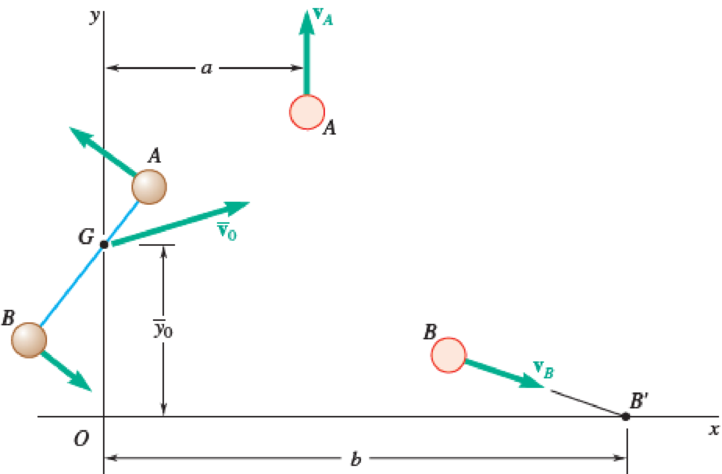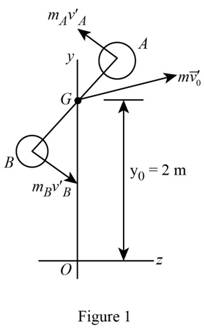
Two small disks A and B of mass 3 kg and 1.5 kg, respectively, may slide on a horizontal, frictionless surface. They are connected by a cord, 600 mm long, and spin counterclockwise about their mass center G at the rate of 10 rad/s. At t = 0, the coordinates of G are
Fig. P14.53 and P14.54

(a)
Find the velocity of A and B after the cord breaks.
Answer to Problem 14.53P
The velocity of A after the cord breaks is
The velocity of B after the cord breaks is
Explanation of Solution
Given information:
The mass
The mass
The cord length AB is
The rate of spin
The coordinates of G,
The velocity
The distance b is
Calculation:
Sketch the disk A and B as shown in Figure 1.

Refer to Figure 1.
The small disks A and B of mass
At location G,
Find the total mass (m) using the relation as follows:
Substitute
Substitute
Find the linear momentum using the relation as follows:
Substitute
Find the angular moment about G using the equation as follows:
Substitute
Find the angular moment about G using the equation as follows:
Refer problem 14.27,
Substitute
Find the kinetic energy
Refer to equation 14.29 in section 14.2A Kinetic energy of a System of particles in the textbook.
Substitute
Sketch the system as shown in Figure 2.

Write the conservation of linear momentum as follows:
Substitute
Substitute
Equate the coefficient i as follows:
Equate the coefficient j as follows:
Express the conservation of energy as follows:
Find the velocity
Substitute
Substitute
Apply the quadratic formula as follows:
Substitute 1 for a, 1.92 for b, and
Thus, the velocity of A after the cord breaks is
Find the velocity
Substitute
The velocity
Find the velocity
Thus, the velocity of B after the cord breaks is
(b)
Find the distance a from the y axis to the path of A.
Answer to Problem 14.53P
The distance a from the y axis to the path of A is
Explanation of Solution
Calculation:
Find the distance a from the y axis to the path of A using the relation:
Substitute
Substitute
Thus, the distance a from the y axis to the path of A is
Want to see more full solutions like this?
Chapter 14 Solutions
<LCPO> VECTOR MECH,STAT+DYNAMICS
- Four masses A, B, C and D are attached to a shaft and revolve in the same plane. The masses are 24 kg, 20 kg, 21 kg, and 18 kg, respectively and their radii of rotations are 50 cm, 50 cm, 60 cm and 30 cm. the angular position of the masses B, C, and D are 60º, 135º and 270º from the mass A. the shaft is rotating with a constant angular speed ω = 500 rpm. We need to find : 1. The magnitude and direction of the resultant inertia force before balancing 2. The magnitude and direction of the balancing mass at a radius of 10 cm The magnitude of the resultant force, in Newton, before balancing is = The direction of resultant force before balancing measured in degree CCW from the mass A is = The magnitude of the balancing mass in kg is = The direction of the balancing mass measured in degree CCW from the mass A is = the magnitude of resultant force after balancing is =arrow_forwardA particle M1, weighing 2.4 Ibs, is tied to a thread and describes a circular path in a horizontal plane. The thread, of negligible mass, passes through a hole in the center of the circle and descends vertically. Another particle M2 is attached, weighing 5.0 Ibs, as shown in the figure. If M1 describes a uniform circular motion, with angular velocity w 3.1 rad/s, determine the radius R of the circumference in inches.arrow_forwardJourney through the Center of the Earth. A 1024-kg blue ball is dropped from an initial z-position of 2.3 x 106 m through the center of a planet with radius 7.6 x 106 m. If the mass of the planet is 33.9 x 1015 kg, measure the displacement of the ball at time t = 9 s?arrow_forward
- Two smooth disks A and B each have a mass of 0.5 kg. Both disks are moving with the velocities shown when they collide. Suppose that (vA)1 = 9 m/s , (vB)1 = 8 m/s. The figure shows two discs, A and B, moving toward the origin of a horizontal xy-plane, where they collide, so that their common tangent lies on y-axis. Disk A moves in negative x-direction with velocity left-parenthesis v subscript A right-parenthesis subscript 1. Block B moves from the third quarter with velocity left-parenthesis v subscript B right-parenthesis subscript 1, directed along an inclined line with a slope of four-thirds. Determine the coefficient of restitution between the disks if after collision B travels along a line, 30∘ counterclockwise from the y axis.arrow_forwardASAParrow_forwardA 1024-kg blue ball is dropped from an initial z-position of 5.4 x 106 m through the center of a planet with radius 6.3 x 106 m. If the mass of the planet is 37.7 x 1015 kg, measure the displacement of the ball at time t = 5 s?arrow_forward
- A uniform cylindrical turntable of radius 1.9 m and mass 30.0kg rotates counterclockwise in a horizontal plane with an initial angular speed of 4pi rad/s. The fixed turntable bearing is frictionless. A lump of clay of mass 2.25kg and negligible size is dropped onto the turntable from a small distance above it and immediately sticks to the turntable at a point 1.80m to the east of the axis. A. Find the final angular speed of the clay and turntable. B. Is the mechanical energy of the turntable-clay system constant in this process? C. Is the momentum of the system constant in this process? Explain your answer.arrow_forwardRod OA rotates counterclockwise at a constant angular rate θ˙ = 4 rad/s. The double collar B is pin-connected together such that one collar slides over the rotating rod and the other collar slides over the circular rod described by the equation r=(1.6cosθ)m. Both collars have a mass of 0.7 kg . Motion is in the horizontal plane. (Figure 1)arrow_forwardRod OA rotates counterclockwise at a constant angular rate 0-4 rad/s. The double collar B is pin-connected together such that one collar slides over the rotating rod and the other collar slides over the circular rod described by the equation r= (1.6 cos 6) m. Both collars have a mass of 0.65 kg. Motion is in the vertical plane. (Figure 1) Figure r=1.6 cos 9. 0-4 rad/s 0.8 m 1 of 1 Part A Determine the magnitude of the force which the circular rod exerts on one of the collars at the instant 0=45 Express your answer to three significant figures and include the appropriate units. ▸ View Available Hint(s) F= Value Submit μÁ Part B Previous Answers Units X Incorrect; Try Again; 5 attempts remaining Determine the magnitude of the force that OA exerts on the other colar at the instant @-45. Express your answer to three significant figures and include the appropriate units. View Available Hint(s)arrow_forward
- A motorcycle and rider have a combined mass of 350kg. At another point in its journey, the motorcycle and rider travel at 80 km/h around a left-hand bend of radius 30m. Calculate: The angular velocity of each wheel, the moment of inertia of each wheel. The angular momentum of the wheel prior to entering the bend. and the magnitude of the gyroscopic torque produced on the bike as the rider is driving around the bend. What is the effect and why is it important to calculate the gyroscopic torque produced on the bike as the rider is driving around the bend? How can you enhance this system?arrow_forwardA 110-kg merry-go-round in the shape of a uniform, solid, horizontal disk of radius 1.50 m is set in motion by wrapping a rope about the rim of the disk and pulling on the rope. What constant force would have to be exerted on the rope to bring the merry-go- round from rest to an angular speed of 0.600 rev/s in 2.00 s? (State the magnitude of the force.) Narrow_forward(a) Determine the z component of the angular momentum HP of particle A about point P using scalar notation. Suppose that mA = 3.4 kg. (b) Determine the z component of the angular momentum HP of particle B about point P using scalar notation. Suppose that mB = 4.2 kg .arrow_forward
 Elements Of ElectromagneticsMechanical EngineeringISBN:9780190698614Author:Sadiku, Matthew N. O.Publisher:Oxford University Press
Elements Of ElectromagneticsMechanical EngineeringISBN:9780190698614Author:Sadiku, Matthew N. O.Publisher:Oxford University Press Mechanics of Materials (10th Edition)Mechanical EngineeringISBN:9780134319650Author:Russell C. HibbelerPublisher:PEARSON
Mechanics of Materials (10th Edition)Mechanical EngineeringISBN:9780134319650Author:Russell C. HibbelerPublisher:PEARSON Thermodynamics: An Engineering ApproachMechanical EngineeringISBN:9781259822674Author:Yunus A. Cengel Dr., Michael A. BolesPublisher:McGraw-Hill Education
Thermodynamics: An Engineering ApproachMechanical EngineeringISBN:9781259822674Author:Yunus A. Cengel Dr., Michael A. BolesPublisher:McGraw-Hill Education Control Systems EngineeringMechanical EngineeringISBN:9781118170519Author:Norman S. NisePublisher:WILEY
Control Systems EngineeringMechanical EngineeringISBN:9781118170519Author:Norman S. NisePublisher:WILEY Mechanics of Materials (MindTap Course List)Mechanical EngineeringISBN:9781337093347Author:Barry J. Goodno, James M. GerePublisher:Cengage Learning
Mechanics of Materials (MindTap Course List)Mechanical EngineeringISBN:9781337093347Author:Barry J. Goodno, James M. GerePublisher:Cengage Learning Engineering Mechanics: StaticsMechanical EngineeringISBN:9781118807330Author:James L. Meriam, L. G. Kraige, J. N. BoltonPublisher:WILEY
Engineering Mechanics: StaticsMechanical EngineeringISBN:9781118807330Author:James L. Meriam, L. G. Kraige, J. N. BoltonPublisher:WILEY





